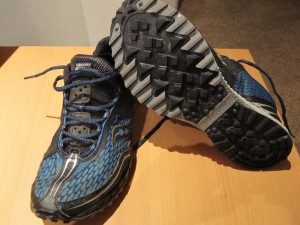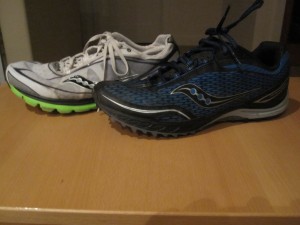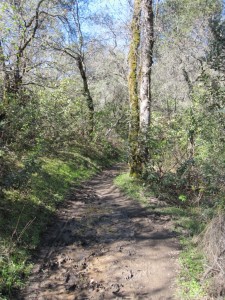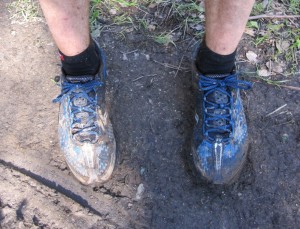Trail Test: Saucony Peregrine Review
I’ve spent the last few months enjoying the roads in a pair of Saucony Kinvara, and I’ve come to appreciate their super light weight, soft ride and minimalist construction. I was looking for a shoe that was more accommodating to my increasingly fore-foot strike. I could feel the thick heel on my regular trainers interfering with the normal mechanics of my foot and Achilles tendon.
The Kinvara, with its lower heel feels much more natural to me. I’d be careful about them if you are a heel striker or need some motion control, as they are a completely neutral shoe. But as I said, I’ve been very happy with them, running distances of up to 22 miles.
But right now, I’m not training for a road race. I’m training for the Way-Too-Cool 50Km and the American River 50, both of which include a wide variety of trails—rocks, mud, technical, hills, etc. Whenever I’d hit the trails for training runs, I’d put on my Montrail Masochists.
The Masochists are a great and surprisingly light-weight shoe, but the heel-toe drop is a full 10mm, while the Kinvara clocks in at only 4mm. (The heel drop is the difference between the thickness of the sole at the heel and the forefoot.) This extra heel height was especially apparent while running steep downhill sections. The Masochist’s higher heel pretty well forces me to land on my heel, and changes my gait completely.
So, as pleased as I’ve been with the Kinvara, I was excited to learn that Saucony had recently come out with a trail shoe built on the same low-profile chassis.
The Saucony Peregrine (retail $90), provides a very similar ride as the Kinvara with an added lug-sole and a little bit of a toe-bumper. It also features a much sturdier feeling upper.
The Peregrine’s sole is a denser “high-traction rubber” with an aggressive tread, and feels considerably stiffer when you flex it by hand.
As soon as I got the Peregrines, I put them on and took them out for a short spin to see how they felt. I ran a short loop from my house (2.75 miles) that included about ¾ mile of muddy dirt road and trail.
The first thing I noticed was that they were surprisingly decent (i.e., comfortable) on the road. This is pretty unusual for a trail shoe, but at 9.1 oz, they are considerably lighter than most trainers. (For example, the Asics Kayano weighs in at 12.9 oz, while the Nike Zoom Vomero is 11.6 oz.) The Peregrines handled well on dirt and grass and seemed grippy enough for the mud. I was pleased–but this was only 2.75 miles. My next scheduled trail run was 30-miles. Were they up to it?
This past Saturday, I met my friend Jen for a long (30-mile) training run from the Auburn Dam Overlook. We’d planned a figure-eight style run coming back to the Overlook after 12-miles to resupply our water and food. This seemed like ideal conditions to try out a completely new shoe. If they weren’t working, I could change out of them after this first section and go back to the old reliable Montrail Masochists.
For socks, I wear Original Weight, Injinji Tetrasok. I have tried many performance, running socks over the years and these are by far my favorite. When I started doing trail ultras, I used to have to put lube on my toes and sometimes even tape them to prevent blisters. Now, all I do is put on these socks. If you haven’t tried them, you should. My only complaints about these socks is that it can take a minute to put them on, and sometimes I’ve been disappointed in their lack of durability. But all in all, a great pair of running socks.
We started off from the parking lot of the overlook and ran a short distance down the road to the horse assembly area. I noticed again how well the Peregrines managed the asphalt. I was already 50+ miles into the week, and my toes appreciated the roomy toe-box. We ran past the horse trough and then down the trail.
It has rained quite a bit lately, although the past couple of days have been clear and cold. In the first hour of our run, most of the puddles were skinned over with ice and the trail crunched under our feet. This section between the Overlook and No-Hands Bridge is notorious for mud and this day was no exception—except that a lot of it was frozen or nearly frozen.
The Peregrines handled the muddy sections well, and their uppers didn’t take on much water when we splashed through the edges of streams we couldn’t quite leap across. They also seemed to grip well on the slippery rocks as we tip-toed across make-shift stepping stones that had been placed in wider streams by previous runners and hikers.
My biggest concern regarding the shoe was whether the there was enough protection in the fore-foot to keep me from bruising on the rocks. I’m a bit of a tenderfoot and this is always an issue for me with trail running. On this front, the shoe performed surprisingly well. Much better, in fact, than I had expected. When we returned to the Overlook (after 12-miles on the trail), I was confident enough to leave the Peregrines on for the duration of the run.
The day was shaping up beautifully, and we shed our knit caps and arm-warmers. I swapped my water bottle for a pack and we hit the trail to Rattlesnake Bar.
The first part of this section of the run is a little more than three miles of downhill fire road to the American River. There is nothing technical until after you get to the river, but it is constantly downhill. The lower heel height of the Peregrine allowed me to keep my natural forefoot strike throughout all the downhill sections. I felt much more fluid and smooth.
The next several miles were mostly single track with some steep ups and downs. The shoes handled everything well, and I gave the toe-bumper a really solid test when I stubbed my left toe on a root and sprawled out on the ground. My toe was fine, even though I gave my hamstring a really good yank.
After we’d turned around and were well on our way back to the road up to the Overlook, Jen remarked on how much better she felt then she did an hour earlier. I agreed, and wondered how much of it was due to the much lighter shoes I was wearing for that run.
We wrapped up the run with a dash up from the river to the Overlook, Jen beating me by 30-seconds or so. Our run ended up being exactly 30-miles in about 4:30.
The verdict on the shoes? Definitely keepers. I look forward to wearing them out this spring!





Hi, very nice review !
1Could you give us some news after 6 months now ? are you still running with it ? have you got any injuries ?
I’m waiting my peregrine now…..:)
Sincerely yours,
Cyrille from France
Thanks for the inquiry! I ran those shoes into the ground and will likely get another pair. I did end up running the Way Too Cool 50K (all trail) and the American River 50 Mile (50% trail) in these shoes. They performed quite well. My only concern about them is that when they get saturated, the insole tends to move around within the shoe and under my feet. When I get a new pair, I believe I will glue them down before I start running in them. Good luck with them!
2John
Thanks for your appreciation ! Do you need to tighten the laces to prevent yourself from the movement of the insole ?
3My last inquirement will concern the cushioning, is it suffisant to prevent injury in downhill? I’m going to do a 23K trail in 18 days, (technical with roots, stones and sand, a typical french forest^^), and I’ve got some tension in my achille’s tendon, so I wonder that if I need to put my heel first, I don’t want my back to be destroy after 5 miles……
Cyrille